When is the Best Time To Visit Iceland? High season or off-season? Summer or Winter? Let us give you a rundown of the pros and cons of visiting Iceland for every month of the year to help you plan the perfect trip.
If you are wondering when is the best time to go to Iceland, you’re not alone. Visiting Iceland has been a bucket list destination for thousands of people since it’s emergence at the top of Lonely Planets Top Places to Visit list all the way back in 2012. But it’s not cheap and it’s not somewhere you go on a whim.
In planning your trip, it is totally understandable that you want to visit Iceland at the right time to make sure you see and experience everything that is on your list. And that’s why we’ve put together this guide – it’s a month by month breakdown of the best time to visit Iceland depending on your interests and weather conditions.
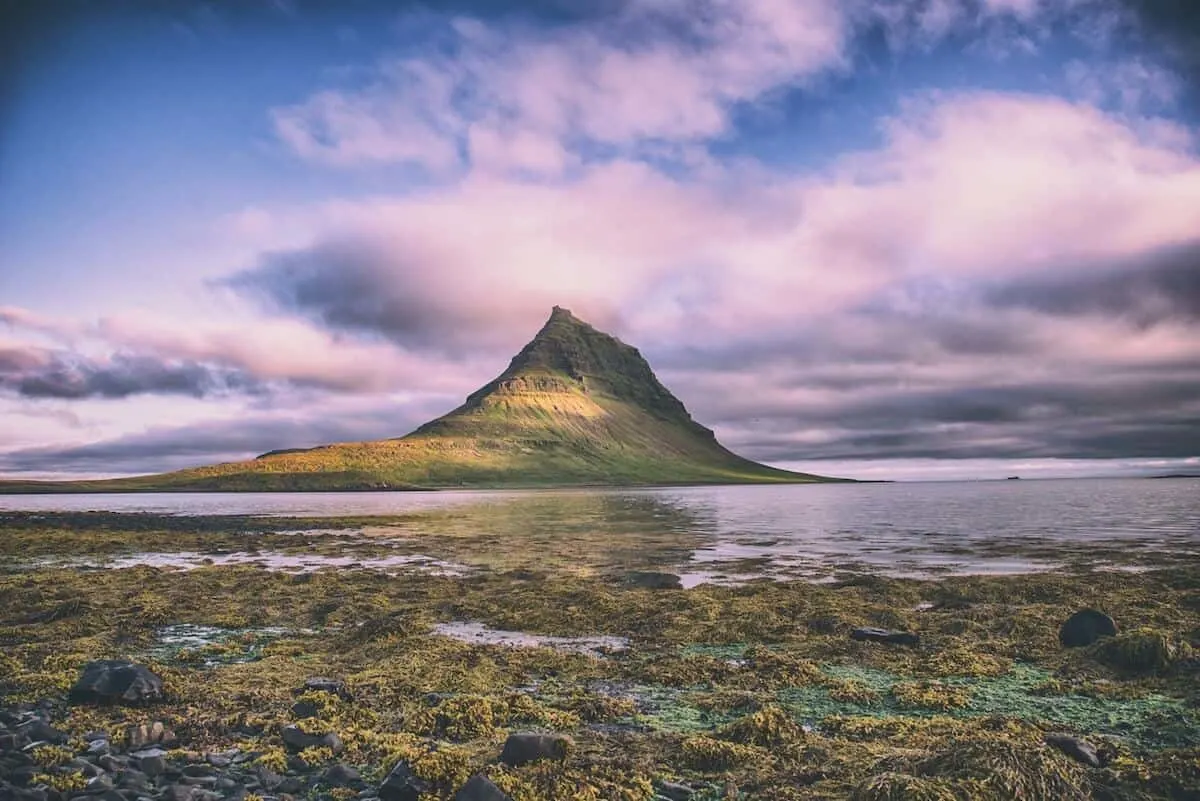 Disclaimer: Almost all posts on this site contain Affiliate links, and this one about the best time to visit Iceland is no different. This means that if you click on any of the links in this post (and make a purchase) I may receive a small commission at absolutely no cost to you. Each post is carefully crafted to (hopefully!) answer all your questions and recommendations are made where we believe they will improve your trip and help with your planning. As such we thank you in advance should you decide to click & buy. Read my full Disclosure here.
Disclaimer: Almost all posts on this site contain Affiliate links, and this one about the best time to visit Iceland is no different. This means that if you click on any of the links in this post (and make a purchase) I may receive a small commission at absolutely no cost to you. Each post is carefully crafted to (hopefully!) answer all your questions and recommendations are made where we believe they will improve your trip and help with your planning. As such we thank you in advance should you decide to click & buy. Read my full Disclosure here.
In This Post
- 1 Best Time To Visit Iceland: A Guide to Visiting Iceland in Winter (December-February)
- 2 Best Time to Go to Iceland: A Guide to Visiting Iceland in Spring (March – May)
- 3 Best Times to Go To Iceland: A Guide Visiting Iceland in the Summer (June – August)
- 4 Best Times to Visit Iceland: A Guide to Visiting Iceland in Autumn (September – November)
Travel Updates & Entry Requirements: Non-Europeans (with the exception of US and UK Citizens) must ensure they have a valid Schengen Visa to visit Iceland.
Best Time To Visit Iceland: A Guide to Visiting Iceland in Winter (December-February)
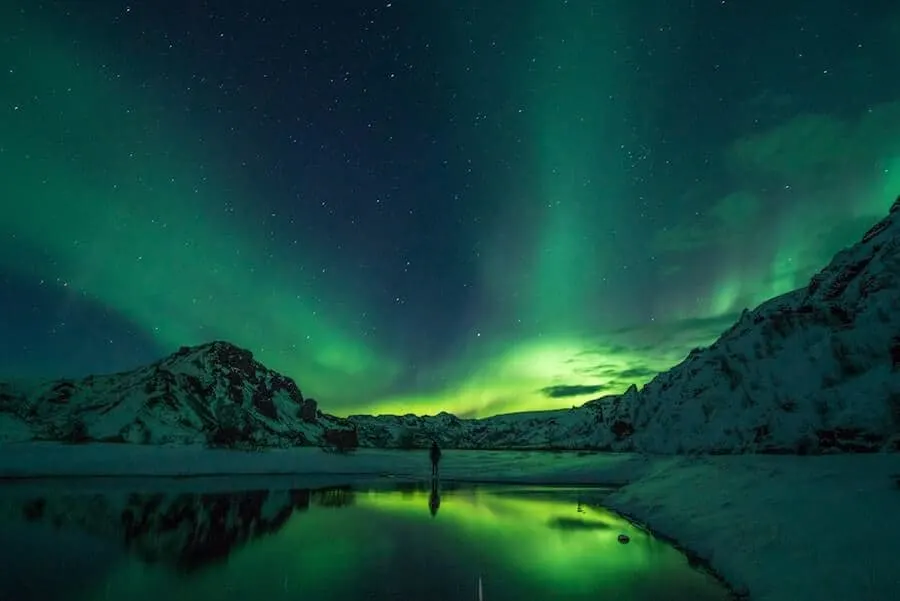
Winter in Iceland offers the best chance of seeing the Northern Lights
If visiting Iceland in Winter, expect short days, cold (but not as cold as you would think) temperatures, a blanket of snow and a high probability of being able to see the aurora borealis (the northern lights).
During the winter months there are limited daylight hours – and on the winter solstice (around 21 December each year) there is as little as 3 hours of daylight! This is great for those on the hunt for the northern lights, and provides a ‘golden hour’ effect for the whole time the sun is in the sky. (It’s also why winter is the best time to visit Iceland for Northern Lights 2024)
When it comes to travel around the country in winter, visitors may find smaller, highland and mountain roads impassible and driving conditions quite challenging, with weather patterns unpredictable.
For those who are not comfortable driving in Iceland in these conditions, there are plenty of organized day tours available to help you see everything and enjoy those winter landscapes as much as possible during the low season.
Things to do in Iceland in Winter:
- Glacier Hiking;
- Snowmobiling;
- Visit one of the Ice Caves;
- The Blue Lagoon (one of the most famous geothermal pools in Iceland);
- Chase the Northern Lights (book early, the Northern Lights tours sell out fast!); and
- Hire a car & self drive the Golden Circle – the roads are well maintained on the 300km loop throughout the year, but there are driving tours running if you don’t want to get behind the wheel yourself.
OUR TOP PACKING TIPS: Pack Thermals! Make sure you have the right travel gear with our guide to what to pack for Iceland (a guide for every season) and be prepared for the winter weather. Iceland in December can be very very cold.
FESTIVALS & EVENTS IN ICELAND WINTER: Celebrate the winter world and the end of a long period of Iceland winter at the Winter Lights Festival.
December
Hours of Daylight: 5 – 4.5
Average Low: -3ºC/27ºF
Average High: 2ºC/35ºF
January
Hours of Daylight: 4.5 – 7
Average Low: -3ºC/27ºF
Average High: 2ºC/35ºF
February
Hours of Daylight: 7 – 10
Average Low: -2ºC/28ºF
Average High: 3ºC/37ºF
,
Best Time to Go to Iceland: A Guide to Visiting Iceland in Spring (March – May)
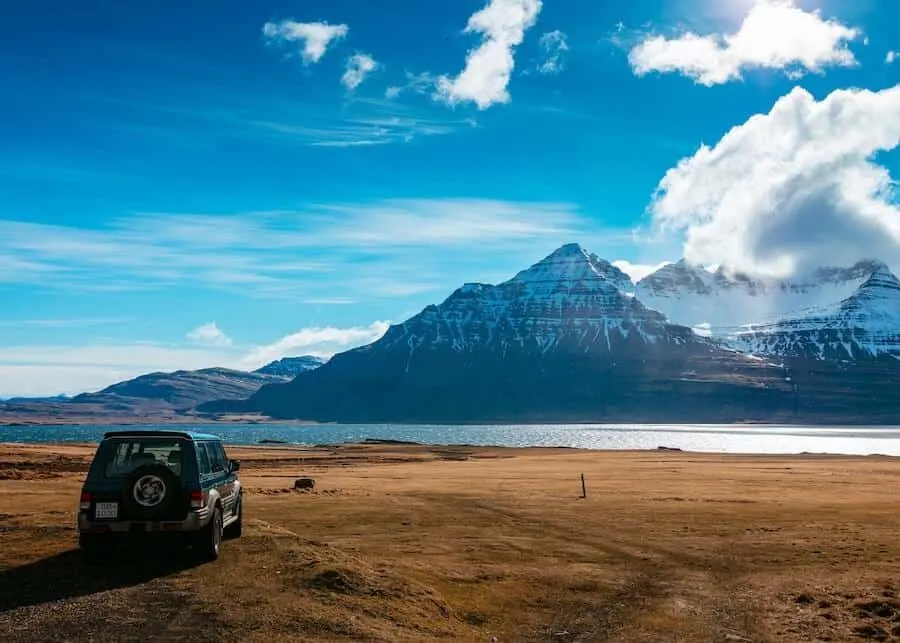
Wondering when the best times to go to Iceland are, or when to visit Iceland 2024? Spring may be the answer you’re looking for!
Whatever the question, Spring in Iceland might just be the answer. As the days get longer, the snow starts to melt revealing Iceland’s lush green landscape for the first time each year.
A contender for the best time to visit Iceland, Spring is shoulder season when prices are lower and tourists are fewer. But for that privilege, expect rain, wind and the occasional sunny day alongside moderate temperatures. (It’s easy to see why Spring is one of the best times to visit Iceland, right?!)
You’ll need a fleece and a rain jacket – and a good pair of waterproof shoes. But with that, there are plenty of opportunities to explore Iceland, gorgeous light for photography, and the opportunity to see the puffins returning to the Iceland coast between mid April and Mid August, and the lambing season in full swing.
There is also a chance to see the Northern Lights until early April, and to experience the waterfalls in Iceland picking up in intensity as the ice melts into the streams and waterways.
Spring is a great time to drive Icelands ring road – not to be confused with the Golden Circle which only takes a few hours to circumnavigate.
The Ring road is a 1300km loop that takes you through some of Iceland’s most spectacular scenery and gives you a great overview of the island. Hire a camper and take a week to drive it. You’ll love camping in Iceland.
Things to do in Iceland in Spring:
- Go on a Puffin Watching Tour and see these beautiful birds in their natural habitat (be sure to add this to your Iceland itinerary if visiting in Spring!);
- Go hiking;
- Play golf;
- Take a dip at Myvatn Nature Baths;
- Go out onto the seas – its a great time for whale watching tour, (there are plenty of boat tours on offer this time of year to see whales);
- Dive between the continental plates at Silfra;
- Go Horseback riding (on Icelandic Horses);
- Go Kayaking;
- Visit the lava fields; and
- get in on the action for the last snowmobiling and glacier walking of the season.
OUR TOP TIP: Pack layers. Thermals, jumpers, t-shirts, light jackets and be prepared to peel them on or off depending on the Iceland weather at the time you get out of the car! (That gulf stream can just jump up on you!)
Ultimately, Spring is a popular answer to the question ‘when to visit Iceland’ and is the best time to visit Iceland for whale watching.
FESTIVALS & EVENTS IN ICELAND SPRING: Spring is Festival Season in Iceland with the Vaka Folk Festival, Eve Fanfest, and three of the top music festivals in Iceland happen in Spring – don’t miss Aldrei For Eg Sudur, Secret Solstice, and Tectronic.
March
Hours of Daylight: 10 – 13.5hrs
Average Low: -2ºC/28ºF
Average High: 3ºC/38ºF
April
Hours of Daylight: 13.5 – 16.75hrs
Average Low: 0.5ºC/33ºF
Average High: 5.5ºC/42ºF
May
Hours of Daylight: 16.75 – 20hrs
Average Low: 3.5ºC/39ºF
Average High: 9.5ºC/49ºF
.
,
Best Times to Go To Iceland: A Guide Visiting Iceland in the Summer (June – August)
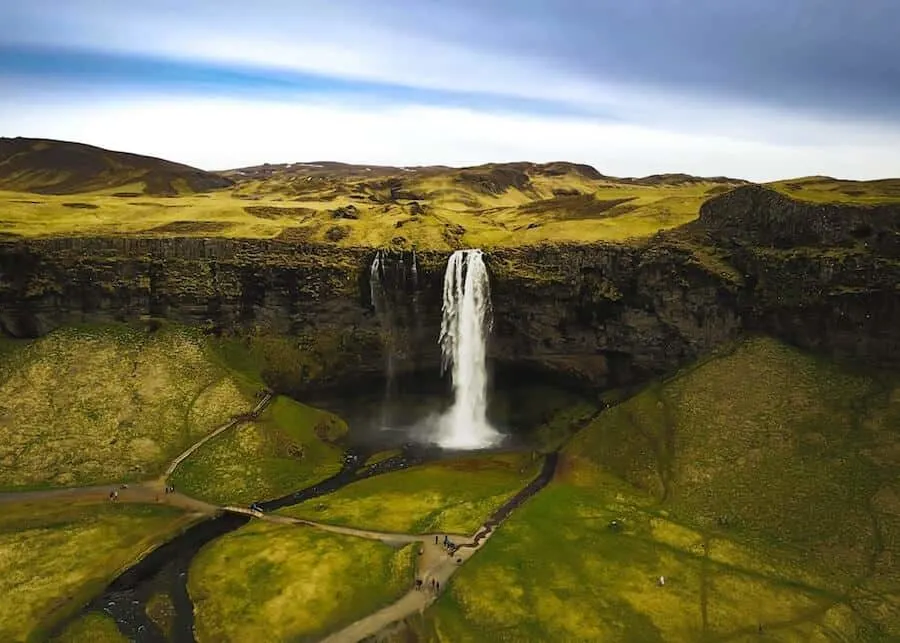 Iceland is your (and everyone else’s!) oyster in the Summer months – and is definitely peak season where visitor numbers swell. The weather is mild (for an arctic circle country), heaps of attractions are open and accessible – and prices soar as tourist season gets into full swing and people visit in droves.
Iceland is your (and everyone else’s!) oyster in the Summer months – and is definitely peak season where visitor numbers swell. The weather is mild (for an arctic circle country), heaps of attractions are open and accessible – and prices soar as tourist season gets into full swing and people visit in droves.
Summer (June and July and August) is easily the most popular time of year to visit Iceland and comes with the best weather. The long days and in particular, the Summer Solstice and longest day of the year boasts 21+ hours of daylight make for some perfect conditions for Iceland photography! (They don’t call it the midnight sun for no reason!) and has a range of natural beauty to discover. Summer is the answer to most peoples question about when to go to Iceland.
Things to do in Summer in Iceland:
All of the outdoor adventures, however, make a note that temperatures average 7-12 degree Celsius.:
- Midnight golf (yes, it’s a thing & a great way to experience the midnight sun!);
- Visit Jokularson Glacier Lagoon (an iconic view in Iceland and a great place to be when the sun sets);
- Tour the Golden Circle;
- Road trips on the Ring Road;
- Go Horse Riding;
- Visit the Black Sand Beaches on the South Coast;
- Go Waterfall Hopping;
- See The Geysers;
- Snorkel Between the Eurasian & American Tectonic Plates;
- The Blue Lagoon;
- Secret Lagoon;
- Take on some of the best hikes in Iceland;
- Lake Mývatn Nature Bath and Nature Reserve;
- Kayaking;
- Volcano Hiking;
- See the Puffins (Until August); and
- Visit the waterfall at Snæfellsnes Peninsula.
OUR TOP TIP: Whatever your travel style, budget through to luxury, we recommend that you pre-book everything. Hotels, (any of the above) Tours, Car Rentals – if you can book it, do it.
And pack an eye mask. Iceland isn’t famous for it’s block-out blinds and the midnight sun can have a negative effect on anyone’s body clock.
Oh, and get in on the Ice-cream action. (A favorite Icelandic pastime is to go for an ice-cream drive (ísbíltúr) to the nearest town.)
– If you can afford to travel, you can afford – and should definitely buy – Travel Insurance (get 5% off with our link)
– For Car Rental (anywhere in the world!) we recommend Discover Cars
– When it comes to packing we’ve reviewed the best Hardside Luggage & Backpacks for Women
PLUS
– Travel Essentials for Women, Backpacking Essentials for Everyone, and Travel Gadgets to make life easier.
FESTIVALS & EVENTS IN ICELAND SUMMER: Seamans Day / Sailors Day is celebrated on the 1st Sunday in June; National Day is celebrated all around Iceland on 17 June; The Great Fish Day happens in Dalvík in August (and is a haven for seafood lovers!); There is the Bræðslan music festival in East Iceland in July and Gay Pride and Culture Night in Reykjavík fall in August.
June
Hours of Daylight: 20 – 21hrs
Average Low: 7ºC/44ºF
Average High: 12ºC/53ºF
July
Hours of Daylight: 21 – 18hrs
Average Low: 8ºC/47ºF
Average High: 13ºC/56ºF
August
Hrs of Daylight: 18 – 14.5hrs
Average Low: 8ºC/47ºF
Average High: 13ºC/56ºF
.
Best Times to Visit Iceland: A Guide to Visiting Iceland in Autumn (September – November)
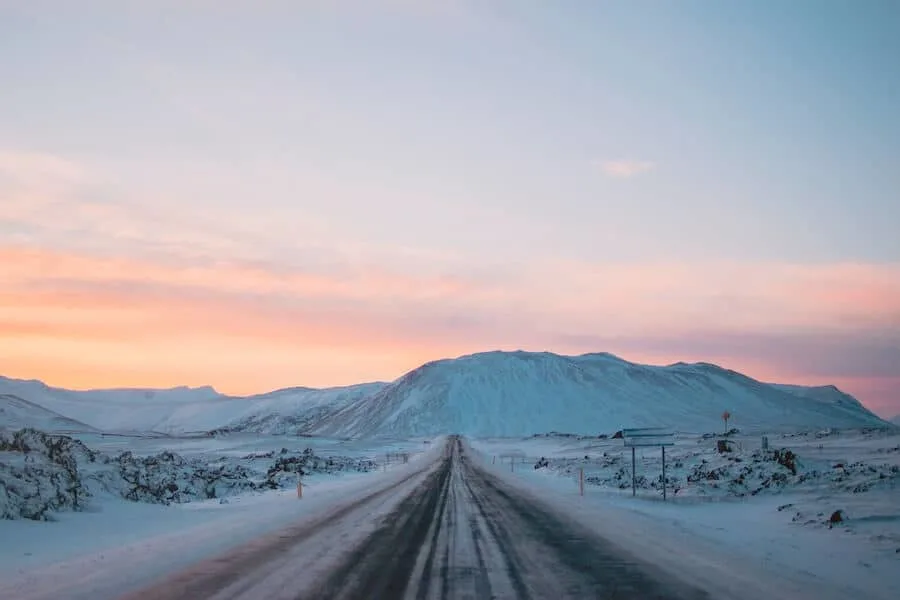
Autumn offers some of the best months to go to Iceland
Iceland in the Fall is awash with color and it is thought of as one of the best time of year to go to Iceland to avoid the crowds.
The National parks are bathed in red, orange and yellow interspersed with patches of green moss across the lava fields which is most vibrant just before the snow arrives. There is still enough daylight for most summer activities but temperatures are slightly cooler and there are fewer tourists with lower prices.
There is also the possibility to see the Northern Lights (aurora borealis) from mid November onwards – however, be warned – to catch them you’ll have to be out late into the night (or very early morning!) and away from any sources of light pollution for any chance to see some aurora activity.
Fall is also classed as off-season and is a great time to visit away from the busy summer crowds and you’ll also benefit from cheaper prices. We’d say that November could be considered the best month to visit Iceland because you have the opportunity to see the Lights and whilst paying slightly cheaper prices.
Things to do in Iceland in Autumn:
Apart for the usual activities (The Blue Lagoon, Golden Circle, Day Trips to Vik, Jokulsarlon glacier lagoon, Diving Silfra and Horseriding etc) you can also
- swim in the many natural pools and hot springs; and
- possibly witness a round up – when the farmers start to gather the sheep and horses before winter sets in.
OUR TOP TIP: Pack a scarf and gloves, whilst temperatures remain above freezing, the weather in Iceland can change on a dime and it’s a good idea to be prepared.
FESTIVALS & EVENTS IN ICELAND AUTUMN: Reykjavik Film Festival & Iceland Airwaves – showcasing new Icelandic and International music.
September
Hours of Daylight: 14.5 – 11.5hrs
Average Low: 5ºC/41ºF
Average High: 10ºC/50ºF
October
Hours of Daylight: 11.5 – 8hrs
Average Low: 2ºC/36ºF
Average High: 7ºC/45ºF
November
Hours of Daylight: 8 – 5hrs
Average Low: -1.5ºC/29ºF
Average High: 3.5ºC/38ºF
The best weather in Iceland is from May to August when you can expect pleasant temperatures, long days. But this is also when Iceland sees the highest number of visitors.
Outdoor lovers and hikers consider the best time to visit Iceland is July and August where temperatures are moderate and there are plenty of activities on offer.
And February, March, September and October (spring and fall in Iceland) are considered the best months to visit Iceland by those seeking to see the Aurora Borealis.
So there you have it – hopefully, this month by month breakdown of the best time to travel to Iceland has been super helpful for trip planning. And you have realized that there is no worst time to visit Iceland as there is plenty going on throughout the year.
Personally, our vote for the best months to visit Iceland goes to Spring or Autumn as the best season to visit Iceland, but after reading this we’ll let you make up your own minds!
What would be your ideal season? Let me know in the comments below.
Oh, and if you enjoyed this guide to the best time of year to visit Iceland, please, tweet pin or share on Facebook – I’d really appreciate it! (click the P in the left-hand share bar to see the hidden pin!)
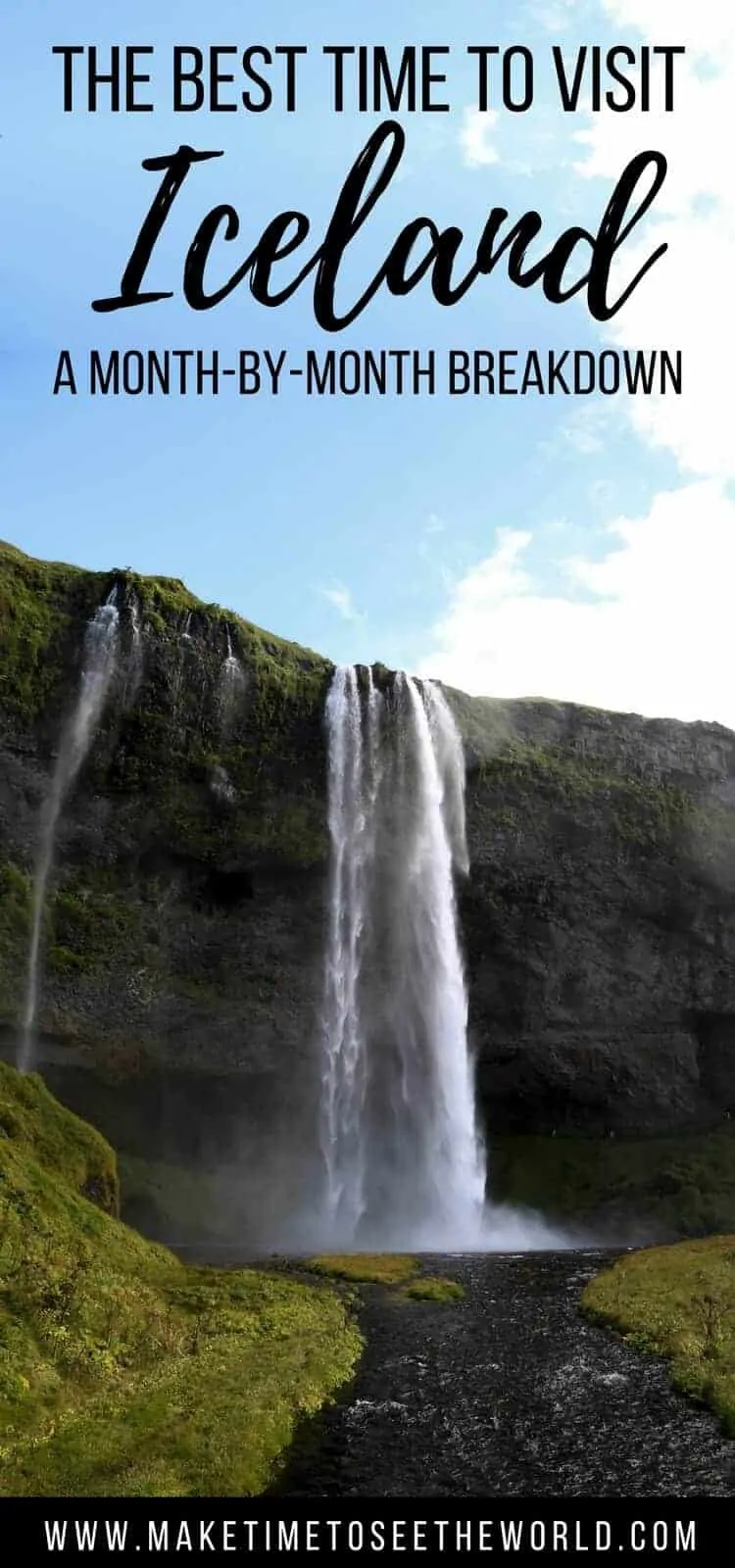
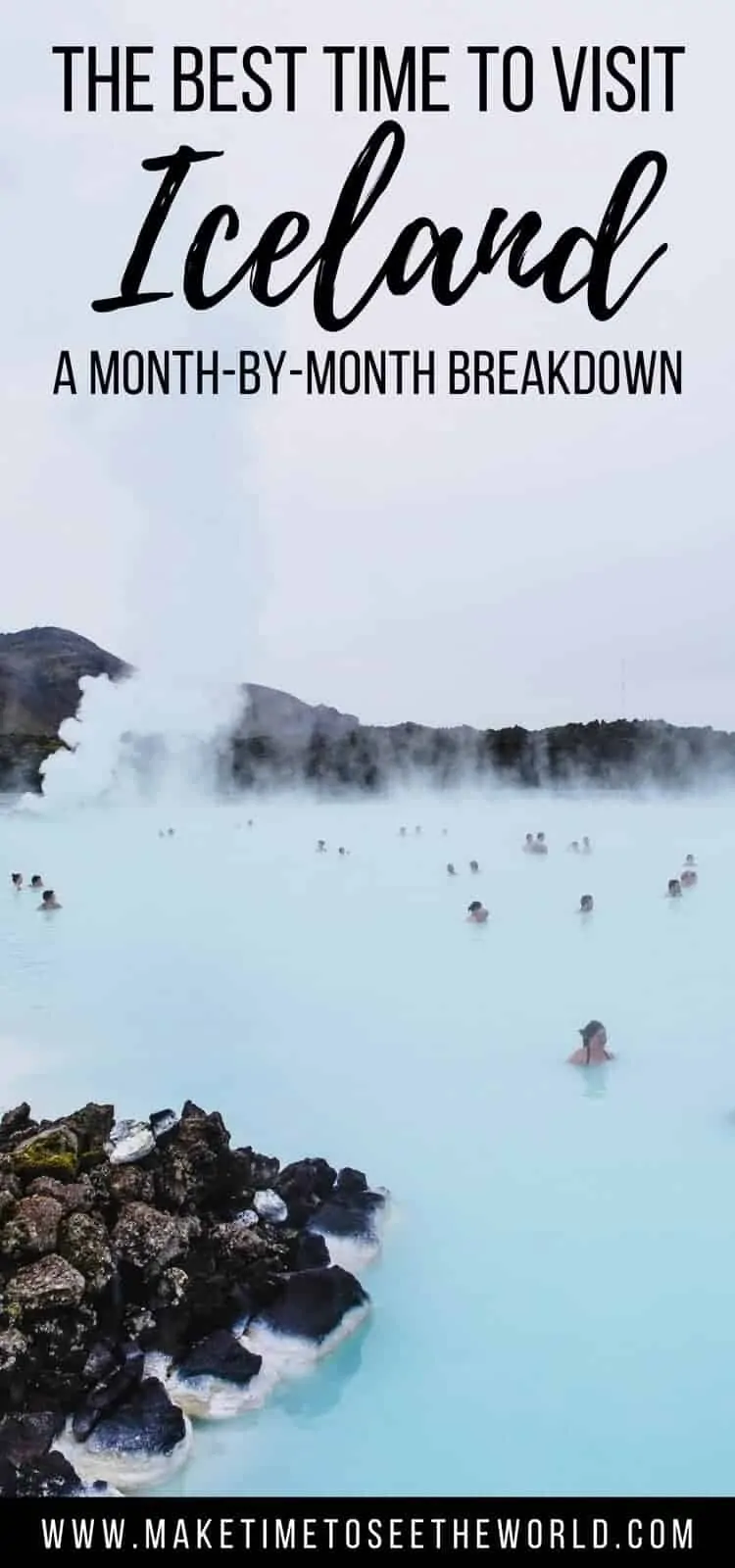
IF YOU LIKED THIS ICELAND TRAVEL GUIDE AND ARE READY MORE TRAVEL INSPIRATION & TRIP IDEAS TO EXPLORE ICELAND AND BEYOND? YOU MIGHT BE INTERESTED IN THESE ARTICLES:
- Awesome Winter Sports Destinations: The Best Places to Ski in the Northern Hemisphere
- Explore Africa: There is so much more than just South Africa! Check out the Most Incredible Places to Visit in Africa and start exploring this incredible continent.
- United States: 30 BEST Places to Visit in the United States
- Travel Quotes: Take your pick from the most wanderlust fueling Travel Quotes of all time!
- Festivals: Festival Fan? You’ll love these Incredible Festivals From Around the World
- Travel Photography: The Best Drones, Camera’s, Backpacks & Travel Photography Tips!
Hi There! Thanks for reading my ultimate guide to The Best Time To Visit Iceland 2024 – A Guide for Every Season. I hope it has answered the question of when is the best time to go to Iceland and I just wanted to let you know that this travel guide contains affiliate links, which means if you purchase something after clicking a link, I may get a small commission – which is at absolutely no cost to you. If you enjoyed this article and are going to be searching for some of the things I mention anyway, I would love it if you could click through from the links above & thank you in advance! Read my full Disclosure here.
And thank you for reading the MakeTimeToSeeTheWorld Travel Blog which also contains guest travel bloggers posts.

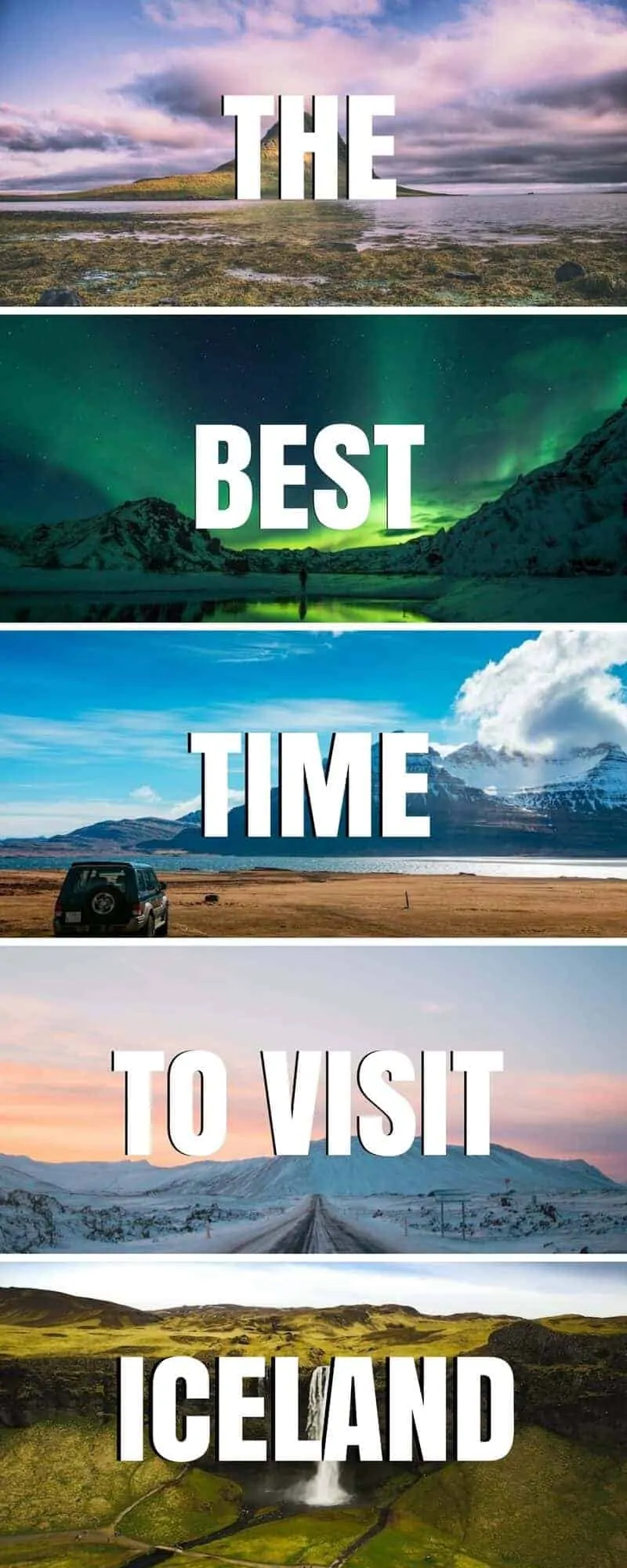
judi petersen
Wednesday 6th of July 2022
do we need a visa to travel to Iceland?
Vicki Garside
Thursday 14th of July 2022
It entirely depends on which country your passport is from.
Iceland is a party to the Schengen Agreement. This means that U.S. citizens may enter Iceland without a visa for up to 90 days for tourist or business purposes, and UK passport holders do not need a visa to visit Iceland.
Avinash Kaur
Sunday 29th of September 2019
Thanks for sharing this. Exactly what I needed to plan my trip. However, I want to do outdoor activities plus northern lights? is it possible during October -November??
Vicki Garside
Sunday 29th of September 2019
Please re-read the post, I have tried to be as clear as possible about what you can do during which months. Unfortunately due to changeable weather and the elusive northern lights, you can never be guaranteed either all the activities that you would like to do or the northern lights sightings that you want.
Dallin
Wednesday 26th of June 2019
I also spent a really good time there during my last summer holidays and came back with smiley faces. In my point of view summer season is a best time to visit this awesome destination.
Jill Troughton
Friday 13th of July 2018
I get the right blog...which I was searching from many times...Thanks for sharing it... I am planning to go Iceland